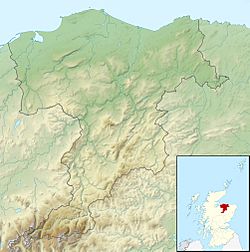Green Castle, Portknockie facts for kids
| Coordinates | 57°42′22″N 2°51′32″W / 57.70607°N 2.85894°W |
|---|---|
| Type | Promontory fort |
| Length | 70 metres (230 ft) |
| Width | 15 metres (49 ft) |
| History | |
| Periods | Iron Age, Pictish |
Green Castle is an old fort built on a rocky cliff in a village called Portknockie, in Moray, Scotland. For a long time, people lived here and built defenses to protect themselves. It was used during the Iron Age and later by the Picts, who were an ancient group of people in Scotland.
Contents
Green Castle: An Ancient Fort in Scotland
Green Castle is located on a natural rocky headland. This means it's a piece of land that sticks out into the sea. It is about 70 metres (230 ft) long and 15 metres (49 ft) wide. The cliffs around it are very steep, rising 20 metres (66 ft) above the water. This made it a great place for a fort because it was naturally protected.
Archaeologists dug up the site between 1976 and 1982. They found many clues about the people who lived there long ago.
Life in the Iron Age
During the Iron Age, people built a simple fence, called a palisade, to protect the landward side of the headland. This was a wall made of strong wooden posts. Archaeologists found traces of where these posts stood.
They also found pieces of pottery, called sherds, and old pits. These finds show that people lived and worked here. They even found evidence of metalworking. This included pieces of moulds, parts of furnaces, hammerstones, and whetstones. This tells us they were making things out of metal.
After this time, the site might have been used for farming. Marks from an ancient plough, called an ard, were found over the Iron Age layers. This suggests the land was tilled before it became a fort again.
The Pictish Era
The site was used for defense again during the Pictish period. First, a new wooden palisade was built. This time, beach stones were used to fill in behind the timber fence, making it stronger.
Later, in the 7th and 8th centuries, the fort was rebuilt. It became much more complex. This might have happened because of Norse (Viking) raids. These raids were starting to threaten the northern Pictish Kingdom of Fortriu.
The new defenses included strong stone walls reinforced with timber. Inside these walls, there was a large stone hall. Sadly, these defenses were later destroyed by fire. This fire was possibly caused by a Viking siege, which is when an army surrounds a place to try and capture it.
Later Uses of the Site
Much later, in the 1800s, Green Castle was used for drying fish. Most of the area was covered by low stone platforms for this purpose. This shows how the site changed over many centuries, from a fort to a place for fishing.


